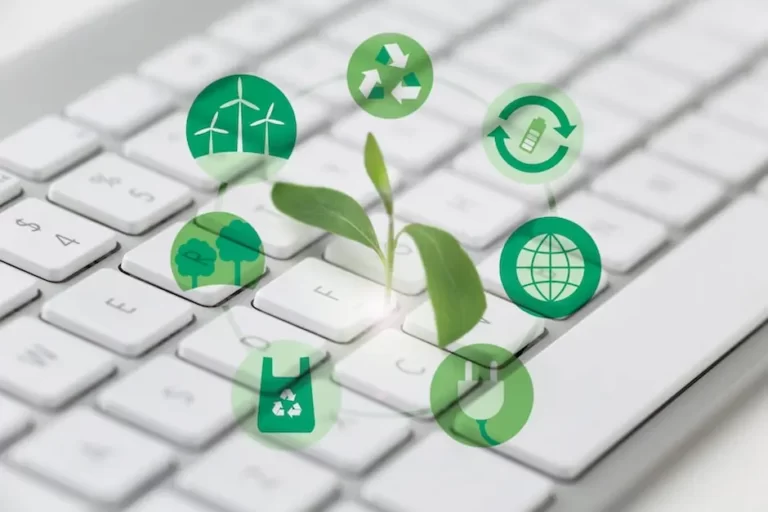In the face of growing environmental concerns, the need for efficient waste management has never been more critical. As we grapple with increasing volumes of waste, traditional methods of waste management are proving to be inadequate. This is where technology steps in, offering innovative solutions to this pressing global issue.
Waste management technology is revolutionizing the way we handle waste, making the process more efficient, sustainable, and environmentally friendly. From smart waste bins to AI-powered recycling robots, technology is at the forefront of this transformation. This blog post will delve into the world of waste management technology, exploring how digital tools, AI, and the Internet of Things (IoT) are reshaping the landscape of waste management.
In the following sections, we will explore various facets of waste management technology, including digital waste management, sustainable waste management, the role of AI and IoT in waste management, and more. Each section will provide an in-depth look at these technologies, their benefits, and their real-world applications. So, let’s embark on this journey to understand how technology is changing the face of waste management, one innovation at a time.
Key Takeaways:
- Waste management technology is transforming the way we handle waste, making the process more efficient, sustainable, and environmentally friendly.
- Digital waste management uses digital tools and software to monitor, manage, and control waste management processes.
- AI and IoT are playing significant roles in waste management, from sorting waste to predicting waste generation patterns.
- Smart waste bins and waste level sensors are enhancing the efficiency of waste collection.
- Pneumatic waste pipes and solar-powered trash compactors represent innovative approaches to waste disposal and management.
Understanding Waste Management Technology
Waste management technology refers to the use of advanced tools and methods to manage and dispose of waste efficiently. It encompasses a wide range of technologies designed to facilitate waste collection, sorting, recycling, and disposal. The goal is not only to make these processes more efficient but also to reduce the environmental impact of waste.
The advent of waste management technology has brought about a paradigm shift in the waste management industry. Instead of merely collecting and disposing of waste, the focus has now shifted towards reducing waste generation, promoting recycling, and converting waste into energy. This shift is largely driven by the growing awareness of the environmental implications of waste and the need for sustainable waste management practices.
The Rise of Digital Waste Management
Digital waste management is an integral part of waste management technology. It involves the use of digital tools and software to monitor, manage, and control waste management processes. This includes everything from smart waste bins equipped with sensors to monitor waste levels to software solutions that optimize waste collection routes for efficiency.
One of the key benefits of digital waste management is the ability to collect and analyze data. By gathering data on waste generation, collection, and disposal, waste management companies can gain valuable insights that can be used to improve their services. For instance, data can reveal patterns in waste generation, which can help in planning waste collection schedules more effectively.
Sustainable Waste Management: A Technological Approach
Sustainable waste management is another area where technology is making a significant impact. The goal of sustainable waste management is to minimize the environmental impact of waste. This is achieved through strategies such as waste reduction, recycling, and waste-to-energy conversion.
Technology plays a crucial role in implementing these strategies. For instance, AI-powered recycling robots can sort waste more accurately and efficiently than humans, thereby improving recycling rates. Similarly, waste-to-energy technologies can convert waste into useful energy, thus reducing the amount of waste that ends up in landfills.
AI in Waste Management: A Game Changer
Artificial Intelligence (AI) is transforming numerous industries, and waste management is no exception. AI in waste management is primarily used for sorting and managing waste more efficiently. AI-powered robots can sort through waste at a much faster rate than humans and with a higher degree of accuracy. This not only improves the efficiency of waste sorting but also significantly enhances the effectiveness of recycling processes.
For instance, AI can differentiate between different types of plastics, ensuring that each type is recycled appropriately. It can also identify and separate recyclable materials from non-recyclable ones, thereby reducing the amount of waste that ends up in landfills. Furthermore, AI can be used to predict waste generation patterns, enabling waste management companies to optimize their operations.
IoT in Waste Management: The Future is Here
The Internet of Things (IoT) is another technology that’s making a significant impact on waste management. IoT involves the use of sensors and other connected devices to collect and analyze data. In the context of waste management, IoT devices can be used to monitor waste levels in real-time, optimize waste collection routes, and even predict future waste generation trends.
Smart waste bins equipped with IoT sensors can send alerts when they are about to be full, enabling timely collection and preventing overflow. Similarly, IoT devices installed on waste collection vehicles can provide real-time data on their location and the amount of waste collected, enabling waste management companies to optimize their operations.
Smart Waste Bins: Revolutionizing Waste Collection
Smart waste bins are one of the most visible manifestations of technology in waste management. These bins are equipped with sensors that can detect when the bin is full and send an alert to the waste management company. This ensures the timely collection of waste and prevents overflow.
In addition to monitoring waste levels, some smart bins are also equipped with compactors that can compress the waste, thereby increasing the bin’s capacity. Others have solar-powered compaction systems, making them a sustainable waste management solution.
Waste Level Sensors: Enhancing Efficiency in Waste Management
Waste-level sensors are a key component of smart waste management systems. These sensors are installed in waste bins and containers to monitor the level of waste in real time. When the waste reaches a certain level, the sensor sends an alert to the waste management company, prompting them to schedule a collection.
The use of waste level sensors can significantly improve the efficiency of waste collection. By ensuring that waste is collected only when the bins are full, these sensors can help reduce the frequency of collections, thereby saving time, energy, and resources. Moreover, the data collected by these sensors can be used to analyze and predict waste generation patterns, enabling further optimization of waste management operations.
AI Recycling Robots: The Future of Waste Sorting
AI recycling robots represent a major breakthrough in waste sorting technology. These robots use AI and machine learning algorithms to sort waste with a high degree of accuracy and efficiency. They can differentiate between different types of waste, such as plastics, metals, and paper, and sort them into separate categories for recycling.
The use of AI recycling robots can significantly improve the efficiency and effectiveness of recycling processes. By ensuring that waste is sorted correctly, these robots can help increase recycling rates and reduce the amount of waste that ends up in landfills. Moreover, by automating the waste sorting process, these robots can also help reduce the reliance on manual labor, thereby saving costs and improving safety.
Garbage Truck Weighing Mechanisms: Optimizing Waste Collection
Garbage truck weighing mechanisms is another innovative technology that’s transforming waste management. These mechanisms are installed on garbage trucks to weigh the waste as it’s collected. The data collected by these mechanisms can be used to optimize waste collection routes and schedules.
For instance, if a particular route consistently generates a large amount of waste, the waste management company can schedule more frequent collections for that route. Conversely, if a route generates less waste, the frequency of collections can be reduced. This can help improve the efficiency of waste collection and reduce the environmental impact of waste management operations.
Pneumatic Waste Pipes: A Modern Approach to Waste Disposal
Pneumatic waste collection systems are an innovative waste management technology that is gaining popularity in urban areas. These systems use a network of underground pipes to transport waste from collection points to a central waste processing facility. The waste is propelled through the pipes by air pressure, eliminating the need for traditional garbage trucks.
The use of pneumatic waste pipes can significantly improve the efficiency of waste collection and disposal. By eliminating the need for garbage trucks, these systems can reduce traffic congestion and greenhouse gas emissions. Moreover, because the waste is transported underground, these systems can also help improve the cleanliness and aesthetics of urban areas.
Solar-Powered Trash Compactors: A Sustainable Solution for Waste Management
Solar-powered trash compactors are another innovative waste management technology. These compactors use solar energy to power a compaction mechanism, which compresses the waste and increases the capacity of the bin. This can reduce the frequency of waste collection, thereby saving time, energy, and resources.
In addition to their environmental benefits, solar-powered trash compactors also have economic benefits. By reducing the frequency of waste collection, these compactors can help save on fuel and labor costs. Moreover, because they use solar energy, these compactors can operate even in areas without access to the power grid.
Conclusion
Technology is transforming the face of waste management, making it more efficient, sustainable, and environmentally friendly. From AI and IoT to smart bins and solar-powered compactors, a host of innovative technologies are reshaping the waste management landscape. As we continue to grapple with the global waste crisis, these technologies will play a crucial role in shaping the future of waste management. By embracing these technologies, we can move towards a more sustainable and waste-free future.
Frequently Asked Questions (FAQs)
-
What is waste management technology?
Waste management technology refers to the use of advanced tools and methods to manage and dispose of waste efficiently. It includes a wide range of technologies designed to facilitate waste collection, sorting, recycling, and disposal.
-
How is digital waste management changing the waste management industry?
Digital waste management involves the use of digital tools and software to monitor, manage, and control waste management processes. It allows for the collection and analysis of data, which can provide valuable insights for improving services and planning waste collection schedules more effectively.
-
What role do AI and IoT play in waste management?
AI is primarily used for sorting and managing waste more efficiently, with AI-powered robots able to sort waste at a much faster rate than humans, and with a higher degree of accuracy. IoT, on the other hand, involves the use of sensors and other connected devices to collect and analyze data, such as monitoring waste levels in real time and optimizing waste collection routes.
-
What are some examples of innovative waste management technologies?
Some examples of innovative waste management technologies include smart waste bins, waste level sensors, AI recycling robots, garbage truck weighing mechanisms, pneumatic waste pipes, and solar-powered trash compactors.
-
How is technology contributing to sustainable waste management?
Technology is contributing to sustainable waste management by promoting strategies such as waste reduction, recycling, and waste-to-energy conversion. For instance, AI-powered recycling robots can improve recycling rates, and waste-to-energy technologies can convert waste into useful energy, reducing the amount of waste that ends up in landfills.

